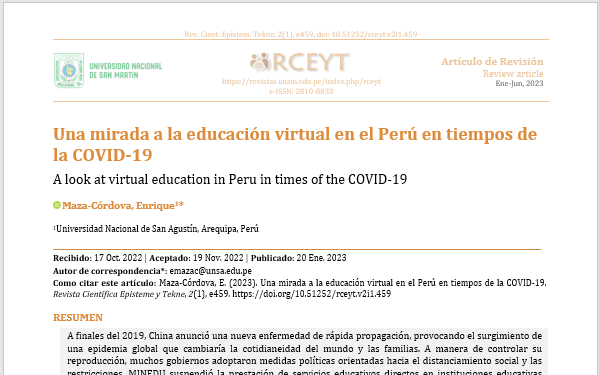A look at virtual education in Peru in times of the COVID-19
DOI:
https://doi.org/10.51252/rceyt.v2i1.459Keywords:
educational gaps, socio-emotional development, social inequalityAbstract
At the end of 2019, China announced a new, rapidly spreading disease, causing the emergence of a global epidemic that would change the daily lives of the world and families. In order to control its reproduction, many governments adopted political measures oriented towards social distancing and restrictions. The MINEDU suspended the provision of direct educational services in public and private basic educational institutions, while the national emergency and health situation would help prevent and control COVID-19. Therefore, the present study proposes to contextualize the Peruvian educational reality during the period of health emergency caused by the COVID-19 pandemic, through the classification and analysis of the state of the art, with an analytical study of documentary research, based on publications from scientific magazines. Education in virtual environments in Peru exacerbated the weaknesses in the educational system, mainly, the widening of the cracks in social and digital inequality. Virtual education in a pandemic managed to separate the educational service by assigning levels according to the economic, geographical and technological conditions of the students and their families. For this reason, we recommend carrying out more studies that address the direct impact of this condition on Peruvian students.
Downloads
References
Abreu-Hernández, L. F., León-Bórquez, R., & García-Gutiérrez, J. F. (2020). Pandemia de COVID-19 y educación médica en Latinoamérica. Revista de La Fundación Educación Médica, 23(5), 237. https://doi.org/10.33588/fem.235.1088
Ávila Font, E. (2003). Las nuevas tecnologías de la información y la comunicación como herramientas necesarias en la formación profesional de los estudiantes universitarios. Etic@net: Revista Científica Electrónica de Educación y Comunicación En La Sociedad Del Conocimiento, 1.
Berger, C., Milicic, N., Alcalay, L., & Torretti, A. (2014). Programa para el Bienestar y Aprendizaje Socioemocional en estudiantes de tercero y cuarto grado: descripción y evaluación de impacto. Revista Latinoamericana de Psicología, 46(3), 169–177. https://doi.org/10.1016/S0120-0534(14)70020-2
Bourgeois, E. (1993). Apprentissage, motivation et engagement end formation. Education Permanente, 136. https://www.education-permanente.fr/public/articles/articles.php?id_revue=136&id_article=1094#resume1094
Casassus, J. (2015). La educación del ser emocional (2nd ed.). Editorial Cuarto Propio.
Cervantes Hernández, R., & Chaparro-Medina, P. M. (2021). Transformaciones en los hábitos de comunicación y sociabilidad a través del incremento del uso de redes sociodigitales en tiempos de pandemia. Ámbitos. Revista Internacional de Comunicación, 52, 37–51. https://doi.org/10.12795/Ambitos.2021.i52.03
Cobo-Rendón, R., Vega-Valenzuela, A., & García-Álvarez, D. (2020). Consideraciones institucionales sobre la Salud Mental en estudiantes universitarios durante la pandemia de COVID-19. CienciAmérica, 9(2), 277–284. https://doi.org/10.33210/ca.v9i2.322
Cotler, J., Cuenca, R., Huber, L., Remy, M. I., Ríos, C. de los, Ames, P., & De Belaúnde, C. (2011). Las desigualdades en el Perú : balances críticos [Ministerio de Educación del Perú]. http://repositorio.minedu.gob.pe/handle/123456789/4787
de Souza, K. R., dos Santos, G. B., dos Santos Rodrigues, A. M., Guimarães Felix, E., Gomes, L., da Rocha, G. L., Conceição, R. do C. M., da Rocha, F. S., & Bezerra Peixoto, R. (2021). Trabalho remoto, saúde docente e greve virtual em cenário de pandemia. Trabalho, Educação e Saúde, 19. https://doi.org/10.1590/1981-7746-sol00309
Defensoría Del Pueblo. (2020). Serie Informes Especiales No 027-2020-DP / La educación frente a la emergencia sanitaria. La educación frente a la emergencia sanitaria. https://www.gob.pe/institucion/defensoria/informes-publicaciones/1110738-serie-informes-especiales-n-027-2020-dp-la-educacion-frente-a-la-emergencia-sanitaria
Erades, N., & Morales, A. (2020). Impacto psicológico del confinamiento por la COVID-19 en niños españoles: un estudio transversal. Revista de Psicología Clínica Con Niños y Adolescentes, 7(no 3), 27–34. https://doi.org/10.21134/rpcna.2020.mon.2041
Gallardo, G. (2016). Reuniones con las familias: Fortaleciendo la relación escuela-familias para promover el pleno desarrollo de niños, niñas y adolescentes. UNICEF. https://bibliotecadigital.mineduc.cl/handle/20.500.12365/18402
Gallardo, G. (2021). Sostener, Cuidar, Aprender. Lineamientos para el apoyo socioemocional en las comunidades educativas (1st ed.). UNICEF.
Iglesias Vidal, E., González-Patiño, J., Lalueza, J. L., & Esteban-Guitart, M. (2020). Manifiesto en Tiempos de Pandemia: Por una Educación Crítica, Intergeneracional, Sostenible y Comunitaria. Revista Internacional de Educación Para La Justicia Social, 9(3), 181–198. https://doi.org/10.15366/riejs2020.9.3.010
Jin, Y., Sun, T., Zheng, P., & An, J. (2021). Mass quarantine and mental health during COVID-19: A meta-analysis. Journal of Affective Disorders, 295, 1335–1346. https://doi.org/10.1016/j.jad.2021.08.067
Lee, J. (2020). Mental health effects of school closures during COVID-19. The Lancet Child & Adolescent Health, 4(6), 421. https://doi.org/10.1016/S2352-4642(20)30109-7
Llerena, R., & Sánchez Narvaez, C. (2020). Emergency, management, vulnerability and responses to the impact of the COVID-19 pandemic in Peru. https://doi.org/https://doi.org/10.1590/SciELOPreprints.94
López de Méndez, A., de los Ángeles Agrinsoni, M., Figueroa Fuentes, W., Or tiz López, R., & Corujo Martínez, G. (2016). Socioemocional. Proyecto ALCANZA. Centro de Investigaciones Educativas. https://alcanza.uprrp.edu/wp-content/uploads/2016/10/modulo_11.pdf
López Jiménez, I. E., & Villafañe Rodríguez, C. (2010). La integración de las tic al currículo: propuesta práctica. Razón y Palabra, 74, 1–17.
Maguiña Vargas, C. (2020). Reflexiones sobre el COVID-19, el Colegio Médico del Perú y la Salud Pública. Acta Medica Peruana, 37(1). https://doi.org/10.35663/amp.2020.371.929
Murillo, F. J., & Duk, C. (2020). El COVID-19 y las Brechas Educativas. Revista Latinoamericana de Educación Inclusiva, 14(1), 11–13. https://doi.org/10.4067/S0718-73782020000100011
OMS. (2019). Un nuevo estudio dirigido por la OMS indica que la mayoría de los adolescentes del mundo no realizan suficiente actividad física, y que eso pone en peligro su salud actual y futura. Organización Mundial de La Salud. https://www.who.int/es/news/item/22-11-2019-new-who-led-study-says-majority-of-adolescents-worldwide-are-not-sufficiently-physically-active-putting-their-current-and-future-health-at-risk
Pinedo-Soria, A., & Albitres-Flores, L. (2020). Virtual medical education in Peru during COVID-19. Revista de La Facultad de Medicina Humana, 20(3), 532–533. https://doi.org/10.25176/RFMH.v20i3.2985
Soto-Córdova, I. (2020). La relación estudiante-docente en tiempos de cuarentena: desafíos y oportunidades del aprendizaje en entornos virtuales. Revista Saberes Educativos, 5, 70. https://doi.org/10.5354/2452-5014.2020.57816
Tomaševski, K. (2001). Human Rights Obligations: Making education available, accessible, acceptable and adaptable. Swedish International Development Cooperation Agency. https://hdl.handle.net/20.500.12365/18061
Vargas Guillen, G. (1988). Algunas características epistemológicas de la investigación documental. Revista de ASCOLBI, 1(3–4), 26–33.
Velavan, T. P., & Meyer, C. G. (2020). The COVID‐19 epidemic. Tropical Medicine & International Health, 25(3), 278–280. https://doi.org/10.1111/tmi.13383
Villamil Jiménez, L. C. (2013). Epidemias y pandemias: una realidad para el siglo XXI. Un mundo y una salud. Revista Lasallista de Investigación, 10(1), 7–8.

Published
How to Cite
Issue
Section
License
Copyright (c) 2023 Enrique Maza-Córdova

This work is licensed under a Creative Commons Attribution 4.0 International License.



